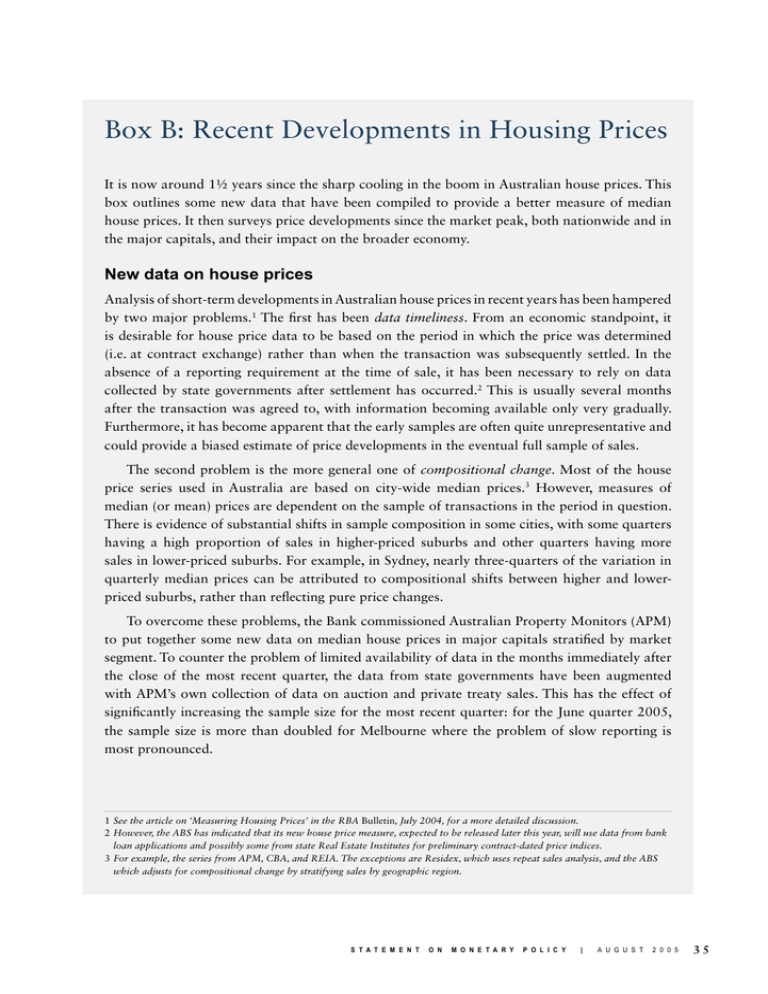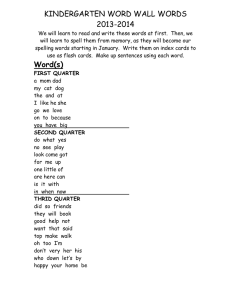Box B: Recent Developments in Housing Prices
advertisement

Box B: Recent Developments in Housing Prices It is now around 1½ years since the sharp cooling in the boom in Australian house prices. This box outlines some new data that have been compiled to provide a better measure of median house prices. It then surveys price developments since the market peak, both nationwide and in the major capitals, and their impact on the broader economy. New data on house prices Analysis of short-term developments in Australian house prices in recent years has been hampered by two major problems.1 The first has been data timeliness. From an economic standpoint, it is desirable for house price data to be based on the period in which the price was determined (i.e. at contract exchange) rather than when the transaction was subsequently settled. In the absence of a reporting requirement at the time of sale, it has been necessary to rely on data collected by state governments after settlement has occurred.2 This is usually several months after the transaction was agreed to, with information becoming available only very gradually. Furthermore, it has become apparent that the early samples are often quite unrepresentative and could provide a biased estimate of price developments in the eventual full sample of sales. The second problem is the more general one of compositional change. Most of the house price series used in Australia are based on city-wide median prices.3 However, measures of median (or mean) prices are dependent on the sample of transactions in the period in question. There is evidence of substantial shifts in sample composition in some cities, with some quarters having a high proportion of sales in higher-priced suburbs and other quarters having more sales in lower-priced suburbs. For example, in Sydney, nearly three-quarters of the variation in quarterly median prices can be attributed to compositional shifts between higher and lowerpriced suburbs, rather than reflecting pure price changes. To overcome these problems, the Bank commissioned Australian Property Monitors (APM) to put together some new data on median house prices in major capitals stratified by market segment. To counter the problem of limited availability of data in the months immediately after the close of the most recent quarter, the data from state governments have been augmented with APM’s own collection of data on auction and private treaty sales. This has the effect of significantly increasing the sample size for the most recent quarter: for the June quarter 2005, the sample size is more than doubled for Melbourne where the problem of slow reporting is most pronounced. 1 See the article on ‘Measuring Housing Prices’ in the RBA Bulletin, July 2004, for a more detailed discussion. 2 However, the ABS has indicated that its new house price measure, expected to be released later this year, will use data from bank loan applications and possibly some from state Real Estate Institutes for preliminary contract-dated price indices. 3 For example, the series from APM, CBA, and REIA. The exceptions are Residex, which uses repeat sales analysis, and the ABS which adjusts for compositional change by stratifying sales by geographic region. S T A T E M E N T O N M O N E T A R Y P O L I C Y | A U G U S T 2 0 0 5 35 To address the more general problem of compositional change, Australian House Prices sales in each quarter in each of the Quarterly percentage change % % capital cities were sorted into ten different groups (five for Canberra) 7.5 7.5 Composition-adjusted based on the longer-term median median 5.0 5.0 sales price for the suburb in which the property was located. Stratifying 2.5 2.5 sales into groups in this way ensures that each group consists of a much 0.0 0.0 more homogenous set of houses -2.5 -2.5 than the city-wide sample of all Standard median sales. Median prices in each of -5.0 -5.0 2001 2003 2004 2005 2002 these individual groups can then be Sources: APM; RBA combined to provide an estimate of price developments in the overall market that is far less affected by compositional change than a conventional city-wide median measure. Graph B1 The combination of the use of data on additional sales, and the stratification of all sales into groups, results in a measure of median house prices for each city that is substantially less volatile than a conventional median and subject to much less seasonality (Graph B1). It is also considerably less subject to revision, even when initial estimates are made soon after the end of a quarter. Recent developments in prices The resulting new median price series confirm that there has been a marked cooling in nationwide house price growth over the past 18 months (Table B1 and Graph B2). In the 18 months prior to the December quarter of 2003, average nationwide prices rose by nearly 30 per cent, but they have been flat in the 18 months since then. Table B1: Composition-adjusted House Prices Percentage change 18 months to Dec qtr 2003 18 months to Jun qtr 2005 25 20 62 35 33 41 29 –7 0 5 9 19 0 0 Sydney Melbourne Brisbane Adelaide Perth Canberra Australia Sources: APM; RBA 36 R E S E R V E B A N K O F A U S T R A L I A This pattern of rapidly rising prices followed by a noticeable slowdown in house price growth is evident, albeit to varying degrees, in each of the capitals. Indeed, it is also evident in every group of suburbs in every capital. Average city-wide prices have fallen or remained unchanged in Sydney, Melbourne and Canberra over the past 18 months. There has been only modest growth in Brisbane over this period, which is a very sharp slowdown from the prior period when prices rose by around 60 per cent. Growth in Adelaide and Perth has also slowed, but in contrast to the other capitals, prices continued to rise at a solid rate over the most recent 18 months, especially in Perth which has clearly benefited from the strength of the resources sector. Graph B2 Composition-adjusted Housing Prices December quarter 1995 = 100, log scale Index Index Houses 245 245 Melbourne 195 195 155 155 Sydney 125 125 Canberra 100 100 Index Index Houses 245 245 195 195 Adelaide 155 125 125 Perth Brisbane 100 Index 155 100 Index Apartments 245 245 195 195 155 155 125 Sydney Melbourne 125 100 100 Composition-adjusted measures 80 80 of apartment prices in Sydney and 1997 1999 2001 1995 2003 2005 Sources: APM; RBA Melbourne, which together account for around 70 per cent of the total capital-city apartment stock, have followed a broadly similar pattern to house prices. Apartment prices rose solidly in the 18 months to the December quarter 2003, but have fallen over the past 18 months. The divergent experience in house prices over the past 18 months appears to be partly related to the extent and timing of the prior build-up in prices. The boom started first in Sydney and Melbourne, with these capitals showing significant growth from 1996. Cumulative growth in house prices from late 1995 to late 2003 was strongest in these two capitals and in Canberra, with prices increasing by around 12 to 13 per cent per year on average in this period. These are also the three cities where house prices have been weakest since late 2003. By contrast, the boom in Perth started later and the cumulative price gain until late 2003 was noticeably less than in other capitals, with prices rising by 9 per cent per year on average over this period. So it may not be surprising that price growth has been strongest in Perth in the subsequent period. Although it is difficult to reach conclusive judgements on the extent of possible overvaluations in house prices, two measures that are sometimes used to shed light on this issue are the ratios of house prices to labour incomes and to rents. In each case, these ratios suggest that housing valuations may have been most stretched in late 2003 in Sydney and Melbourne. For example, S T A T E M E N T O N M O N E T A R Y P O L I C Y | A U G U S T 2 0 0 5 37 Graph B3 Capital City House Prices to State Wages Smoothed Ratio 10 Ratio 10 NSW 8 8 Queensland 6 Victoria 4 6 Western Australia 4 ACT the ratio of capital city house prices to (state-wide) annual earnings had risen sharply in these two cities, to levels well above those in the other capitals (Graph B3).4 Similarly, gross rental yields had also fallen to particularly low levels in these cities (Graph B4). Hence the price weakness in the two largest cities over the past 18 months appears to partly reflect an unwinding of earlier unsustainable movements in prices. South Australia 2 1991 1998 2005 1991 1998 2 2005 Sources: ABS; REIA The relationship between house prices and the broader economy Graph B4 Given the importance of housing in the macroeconomy, it is not Three-bedroom houses, smoothed surprising that the sharp slowing % % in the growth of house prices has Brisbane been associated with a slowing in Adelaide 7 7 the growth of domestic demand. Melbourne The earlier long boom in house Canberra prices was accompanied by a sharp 5 5 rise in residential building activity. Perth However, this was reversed with 3 3 the cooling of the price boom, with Sydney the number of nationwide private residential building approvals 1 1 1990 1995 2000 2005 1995 2000 2005 falling by 11 per cent between the Source: REIA December quarter 2003 and the June quarter 2005, despite picking up in the first half of 2005. House price developments appear to have also had broader effects on spending by households. Whereas nationwide real retail sales had risen by nearly 10 per cent in the 18 months to the December quarter 2003, growth slowed to 4½ per cent over the period to June 2005. Although the state-level data for building approvals and retail trade data are fairly volatile, state developments do tend to be correlated with house price developments (Table B2). For example, activity in Western Australia has remained stronger than the nationwide average while activity in NSW and the ACT has been relatively weak, consistent with developments in house prices. Residential Property Gross Rental Yields 4 However, there is cross-country evidence that ratios of house prices to labour income tend to be higher in larger cities: see the article on ‘City Sizes, House Prices and Wealth’ in the RBA Bulletin, December 2001. 38 R E S E R V E B A N K O F A U S T R A L I A Table B2: Composition-adjusted Capital City House Prices and State Economic Activity Percentage change over the 18 months to the June quarter 2005 Composition-adjusted house prices(a) Residential building approvals Real retail sales –7 0 5 9 19 0 0 –23 1 –10 –20 –5 –41 –11 2 7 4 2 9 2 4 NSW Victoria Queensland South Australia Western Australia ACT Australia (a) Refers to movements in capital city house prices for each state. Sources: ABS; APM; RBA Of course, developments in house prices have not been the only cause of the different outcomes experienced by state economies over the recent period. Nor has the impact been completely from house prices to economic developments, as opposed to vice versa. However, the state-level data are consistent with developments in house prices having had major direct and indirect effects on the Australian economy and having contributed to the recent slowing in the growth of domestic demand. As the Bank has noted in other contexts, this slowing in demand is part of a consolidation of household balance sheets and was unavoidable given the sharp runup in household borrowing that accompanied the rapid increase in house prices. The correction in the housing market appears so far to have proceeded reasonably smoothly, and the prospect of an excessive and unwelcome slowing in domestic demand has been reduced by the boost to national incomes coming from the favourable terms of trade. R S T A T E M E N T O N M O N E T A R Y P O L I C Y | A U G U S T 2 0 0 5 39








